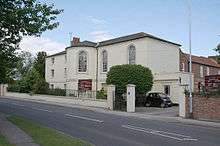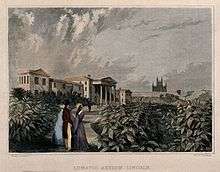Richard Ingleman
| Richard Ingleman | |
|---|---|
|
The Lawn, Lincoln | |
| Born |
1777 Southwell |
| Died |
11 January 1838 Southwell |
| Nationality | English |
| Occupation | Architect |
| Buildings | Southwell House of Correction; The Lawn, Lincoln; Warneford Hospital, Oxford |
Richard Ingleman (1777-1838) was a surveyor and architect of Southwell in Nottinghamshire, England. Initially his architectural practice was based on the Southwell area, but he won widespread respect for his designs for the Southwell House of Correction (1807-8). This led to his gaining major commissions for prisons and mental hospitals, particularly in Wiltshire and at Oxford.[1]
Career
Richard Ingleman was the son of Francis Ingleman, a surveyor and builder of Southwell, and the grandson of Richard Ingleman, a mason who repaired Southwell Minster after a lightning strike in 1711. Richard Ingleman is first noted as a Surveyor to the fabric of Southwell Minster, a position he held from 1801 to 1808.[2] In 1807 he designed the Southwell House of Correction, a prison which was seen as a model for other prisons. This operated the silent system which required the prisoners to work in groups and to remain silent at all times. This was to give him an interest in prison and institutional design.[3] He entered unsuccessfully the competition in 1812 for the design of the Milbank Penitentiary which was to be built on the present site of the Tate Gallery. However he was successful in two other large prison projects, the rebuilding of Devizes New Bridewell[4] and the Fisherton Anger House of Correction in Salisbury. The Devizes New Bridewell was started in 1810 and at the same time Ingleman started supervising the building of the Nottingham Lunatic Asylum. It was not until 1817 that he started on the Fisherton Anger House of Correction, but by this time he had been approached to design the Warneford Mental Hospital at Oxford. This was built between 1821 and 1826. In 1826 Ingleman wrote to the Trustees of the Warneford Hospital saying that he was now incapacitated by illness and asked for the final payment of £50 for the completion of the hospital. Ingleman does not appear to have undertaken any further architectural work after this date and he died at Southwell in 1838 at the age of 51.
Howard Colvin notes that Ingleman's asylums were classical buildings of no special distinction, but the unexecuted plans he submitted for the re-building of Shelton Church, Nottinghamshire, were an essay in Early English style which were quite creditable for the time.[5] He undertook some country house building and favoured the use of Ionic columns for porches and porticos. This is seen at Conock House near Devizes and at Ordsall Rectory (now Ordsall Hall) in Nottinghamshire, while he used massive Ionic columns for the portico to the Lawn Asylum in Lincoln.[6]
Architectural work
- Southwell Minster, Nottinghamshire. Repairs to the fabric 1801-5 including the removal of the two pyramid-shaped spires from the two western towers.[7]
- The Assembly Rooms, Southwell, Nottinghamshire. These adjoin the Saracen’s Head.[8]
- The Residence House, Southwell, alterations and improvements 1806-9.[9]
- The House of Correction, Southwell, Nottinghamshire. 1807. Extended in 1817.[10]

- Southwell Parish Workhouse 1808. A parish workhouse for 84 inmates in Moor Lane in Southwell in 1808. It was designed by the Revd John T Becher in association with a local architect, believed to be Richard Ingleman. Becher published the plan of the workhouse in 1828 in his book The Anti-pauper System.[11] When the Thurgaton Wapentake or Union workhouse was built in 1824 the building was no longer needed and it was converted into a Baptist Chapel.[12]
- Devizes House of Correction, Wiltshire, 1810-17. The prison was a polygon of brick and stone with the governor's building in the middle. There were 210 cells, 16 yards, 2 infirmaries and a chapel.[13]
- Nottingham, The Lunatic Asylum, 1810-12.[14]
- Conock House, nr. Devizes, Wiltshire. Added Ionic porch and wings for E. Warriner in 1817.[15]
- Ordsall Rectory (now Ordsall Hall), Nottinghamshire 1819. According to Pevsner: "A two storey stucco house of excellent proportions".[16][17]
- Fisherton Anger Prison, Salisbury. 1817. This was the Wiltshire County Prison and plans survive in the Wiltshire County Record Office.[18] The plans are No. 1. ground plan; no. 2. chamber plan; no. 3. attic plan; no. 4. elevation of the lodge: no. 5. elevation of the end of the Infirmary Wards, communication passages and central building. Only the central block survives today as New Radnor House.
- The Woodborough Prebend, Southwell, c. 1818. New frontage added to an earlier house.[19]

- The Lawns, Mental Hospital, Lincoln. 1819-20.
- The Grammar School, Southwell, 1820. Erected on the site of the Chantry Priests house; remained in use until 1964.[20][21]
- Rydd Court, Worcestershire.[22]
- The Warneford Mental Hospital, Oxford, 1821-6.[23] Originally known as the Oxford Lunatic Asylum, it later became known as The Radcliffe Asylum, and after 1843, as the Warneford Lunatic Asylum. It was intended for three classes of non-pauper patients who would pay for their care according to their financial circumstances.
Gallery of work by Richard Ingleman
|
References
- ↑ "Colvin" (1995), 525-6
- ↑ "Colvin" (1995), 525
- ↑ Shilton R.P A History of Southwell
- ↑ Waylen J. (1839) Chronicles of Devizes pg 318
- ↑ "Colvin" (1995), 525-6
- ↑ "Antram" (1989) – implies that the columns and portico were later than 1820, but they must surely be part of Ingleman's original design.
- ↑ Summers N, (1972) Southwell Minster pg. 23
- ↑ Pevsner (1979), pg. 333
- ↑ Pevsner (1979), pg. 331
- ↑ Pevsner (1979), pg. 331
- ↑ Southwell Workhouse
- ↑ "Pevsner" (1979), pg.334
- ↑ "Waylen "(1839) pg 318
- ↑ "Colvin" (1995), 526
- ↑ "Colvin" (1995), 526
- ↑ Pevsner (1979), pg. 283
- ↑ "Colvin" (1995), 526
- ↑ "Plans for the county gaol at Fisherton Anger by R. Ingleman of Southwell, Notts.". The National Archives. 1817. Retrieved 26 April 2016.
- ↑ Pevsner (1979), pg. 331
- ↑ "Colvin" (1995), 526
- ↑ Hutchins D. (2010), ‘‘The History of the Minster School’’
- ↑ "Colvin" (1995), 526
- ↑ "Colvin" (1995), 526
Literature
- Nikolaus Pevsner; John Harris; Nicholas Antram (revised) (1989). The Buildings of England: Lincolnshire. Yale University Press. ISBN 978-0-300-09620-0.
- Howard Colvin (1995). A Biographical Dictionary of British Architects, 1600-1840. Yale University Press. pp. 525–6. ISBN 978-0-300-12508-5.
- Morrison K. (1999), The Workhouse: A Study of Poor -Law Buildings in England, English Heritage/RCHME, ISBN 9781873592366
- Parry-Jones B. (1976), The Warneford Hospital, Oxford.
- Nikolaus Pevsner; Elizabeth Williamson (1979). The Buildings of England: Nottinghamshire. Yale University Press. ISBN 978-0-300-09636-1.
- Smith R. (2015) Nottinghamshire House of Correction, Southwell (1611-1880): A Model Institution: Essential History and Architectural Notes, Southwell and District Local History Society. ISBN 978-0-9932442-2-3
- Summers N., A Prospect of Southwell.
External links
![]() Media related to Richard Ingleman at Wikimedia Commons
Media related to Richard Ingleman at Wikimedia Commons
- Rev J.T.Becher Heritage Trail – leaflet by Southwell Tourism Partnership
.jpg)

.jpg)

.jpg)